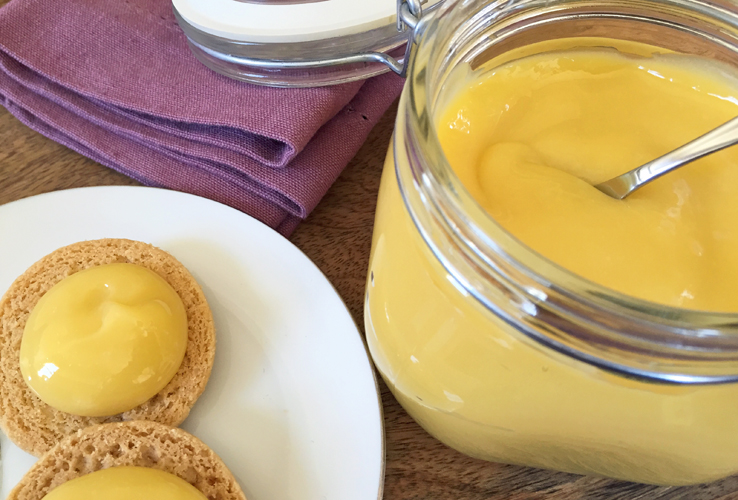So, let’s say you zest 10 or 12 Meyer lemons for Organic Meyer Lemon Limoncello, leaving you with a bunch of nekkid fruit. And then? Juice them, of course. And then? Then you have about a pint of Meyer lemon juice. And then? Exactly. Now you have to come up with a way to use up that lovely, fresh lemon juice. Sure, you can dip into that pint when making salad dressings, lemonade, lemon sorbet, and so on, but what about a recipe that really lets the fresh, unique flavor of Meyer lemons shine — and makes a serious dent in the amount of lemon juice taking up space in your refrigerator?
The answer to “And then?” is Meyer lemon curd! Having luscious, creamy, tangy-sweet lemon curd on hand means that you’re halfway to quick lemon tarts, lemon bars, or a sunny topping for pound cake or scones. Sweet! (Dude!)

Lemon curd is not a jam or a sauce, it’s actually a custard (although you can thin it with juice or cream to make it saucy). Other sweet treats that are custards? Crême brulée and ice cream, for example. A custard, by definition, is a combination of eggs, milk or cream, and sugar, typically cooked either on the stovetop or in the oven. Lemon curd substitutes lemon juice for the milk or cream and gets its creamy mouthfeel from the addition of butter at the end of the cooking process.
While Meyer lemon curd seemed like a good waste-less solution to too much lemon juice and some eggs that were teetering on being too old to keep around, finding the right recipe was a bit of a problem. My go-to lemon curd recipe calls for a small pile of zest and egg yolks (not whole eggs, just yolks). Not an ideal solution because I’d end up with leftover egg whites and more nekkid lemons, which meant more juice. Hmmm, this didn’t seem to sit right with the Waste-Less Wednesday mission to reduce waste. I was trying to reduce waste, not create more.
What I needed was a lemon curd recipe that met these criteria:
- No zest required
- Whole eggs or whole eggs plus one or two yolks (Why one or two? Because you can easily use up one or two egg whites making an egg-white omelette or Pisco Sours!)
- Not too sweet
- No straining necessary
So what about that last part — no straining? No, I’m not referring to the amount of physical effort required to make the curd! Depending on how you cook the lemon curd, you can end up with some cooked egg bits in the finished curd that you’ll need to strain out if you want a completely smooth lemon curd. Temperature is the culprit here. Egg whites cook more quickly than egg yolks, so it’s key that you whisk the egg whites and yolks together thoroughly before you start cooking the curd.
Cooking technique is also a factor. Recipes that call for cooking lemon curd directly over heat (as opposed to in a double-boiler setup) — or even boiling the curd — can result in uneven or too much heat too quickly, causing the eggs in the mixture to curdle. What you need to know about cooking custards is that you want to cook them low and slow — with evenly distributed heat. That’s why custards are often cooked in or over water baths. So, really all lemon curd needs is a double-boiler setup and your undivided attention for 10-15 minutes.
Ah, where to find this unicorn of lemon curd recipes? It was a quest — through a dozen cookbooks and magazines and half a dozen online recipe sites.

Who knew there were so many different (and yet similar) lemon curd recipes in the world? After all of that research, I can’t say that I found one recipe that met my criteria for ingredients and technique together, but I had some reliable sources to draw on for inspiration in creating my own easy-to-make, rich lemon curd.
What did I learn?
- You can make a flavorful lemon curd without zest (adding zest to the mix will amp up the flavor, no doubt, but it’s not required)
- Egg yolks give the curd its vibrant yellow color and rich flavor, so use eggs with rich yolks
- Balance between sweet and tart is essential, so the amount of sugar should be less than or equal to the amount of juice in the recipe
- You can cut out the straining step by keeping the cooking temperature even and stirring the mixture continuously
Have you made lemon curd? With or without zest? Strained or not? Share your thoughts and experiences in the column below.
Recipe: Meyer Lemon Curd
Inspired by: The Culinary Institute of America and Ripe for Dessert by David Lebovitz
Yield: About 16 ounces
Here it is: a zest-free, no-strain, minimal-waste, creamy lemon curd with all the sweet tangy flavor of Meyer lemons. (Note that I do include an optional straining step, in case you need it.) Make sure that you can commit an uninterrupted 10-15 minutes to the cooking process. You need to stir the curd continuously during this time. Serve this luscious treat as a complement to plain baked goods, such as cakes or scones, as a topper for waffles, or with fresh berries.
What you need:
Double-boiler or 2-quart saucepan and Pyrex or stainless steel bowl that fits securely in the top of the saucepan
Whisk
Wooden spoon
Kitchen towel or hot pad
Medium-sized Pyrex or stainless steel bowl
9″ x 13″ metal baking pan for ice-water bath
2 dozen ice cubes
Optional: Instant read-thermometer
Optional: Fine-mesh strainer
Ingredients:
6 ounces freshly squeezed Meyer lemon juice
6 ounces fair trade organic sugar
2 large eggs
2 egg yolks, from large eggs (total weight of eggs plus yolks is about 5 ounces)
3 ounces sweet butter, cut into small pieces
Pinch of salt

How to:
- Fill the saucepan with approximately 2 inches of water, cover with a lid, and bring to a simmer. Turn the heat to medium-high.
You want to be sure that there’s enough water to keep the simmer going, but not so much that the insert or bowl will be immersed in water when you place it on top of the saucepan. Also, you shouldn’t see any steam coming from the saucepan. If, at any time during the cooking process, steam starts to come out of the saucepan, turn down the heat.
- Prepare the ice-water bath. Fill the baking pan with a dozen ice cubes and then add enough water to fill the pan about halfway. Place a clean, medium-sized bowl in the baking pan.
- In the other bowl or double-boiler insert, whisk the eggs until yolks and whites are well combined, adding the pinch of salt.
- Stabilize the bowl or insert by placing a rubber jar opener or folded wet kitchen towel underneath, then whisk in the juice.
Pour the juice in slowly with one hand, while whisking to combine it with the eggs using the other hand. For example, if you’re right-handed, pour the juice into the eggs with your left hand, and whisk with the right.
Whisking in the juice: make sure you stabilize the bowl with a rubber pad or wet towel underneath - Whisk the sugar into the egg and juice mixture.
Use the same technique as you did to whisk in the juice. - Place the bowl or insert into the saucepan over the simmering water and, using the whisk, stir continuously for about 10 minutes, until the mixture starts to thicken.
For the first five minutes, nothing will happen, but keep stirring at a slow-to-medium pace. Around the 8-minute mark you’ll notice a little thickening, barely. Don’t stop stirring. You’ll want to keep the mixture moving the entire time so it cooks evenly and doesn’t have a chance to curdle. I’m not kidding. Don’t stop. Don’t step away for a minute, or you might end up with lemon scrambled eggs.
Five minutes in and nothing yet, but keep stirring for even cooking - After 10-12 minutes test for doneness and temperature. You want to cook the mixture until its thickened and an instant-read thermometer reads 175° F.
If you don’t have an instant-read thermometer, try this old-school method of testing doneness: dip the back of a wooden spoon in the mixture. The curd should coat the back of the spoon. If not, keep stirring and cooking. If the spoon is coated, run your finger through the curd that sticks to the spoon. If the gap doesn’t close at all, the curd is ready to come off the heat.
- Turn off the heat, and remove the bowl or insert, placing it on a folded towel. Add half the butter cubes to the mixture and whisk until completely melted and combined. Then add the other half, again, whisking until completely combined.

Whisking in the butter after taking curd off the heat As the curd cools, it will continue to thicken, so don’t worry if doesn’t seem thick enough now. However, residual heat will continue to cook the curd, so it’s important to bring the temperature down as soon as possible, which is why you want to get the curd into an ice-water bath.
- Add the remaining dozen ice cubes to the prepared ice-water bath.
- Optional: Sometimes you’ll end up with a few bits of cooked egg whites in the curd. If you want a completely smooth curd, you can strain it through a fine-mesh sieve into the bowl in the ice bath. Use a rubber spatula to press the curd through the sieve.
I had a few bits of egg white in my curd, but they’re so tiny that I could have skipped the straining.
Those tiny white flecks are bits of egg white that cooked too quickly - If you skipped step 10, use a rubber spatula to scrape the curd from the double-boiler insert or bowl into the clean bowl in the ice bath.
- Cover the curd with a piece of plastic wrap so that the curd doesn’t develop a “skin.”

Keep your curd skin-free: place a piece of plastic wrap directly on top - Top up the water in the baking pan so that it’s equal with or slightly above the level of the curd in the bowl.
- Place the ice bath (with curd bowl) in the refrigerator and allow the curd to cool for 1-2 hours before serving.
- Store in a covered container in the refrigerator for about 3 weeks.





2 thoughts on “Waste-Less Wednesday: Meyer Lemon Curd”